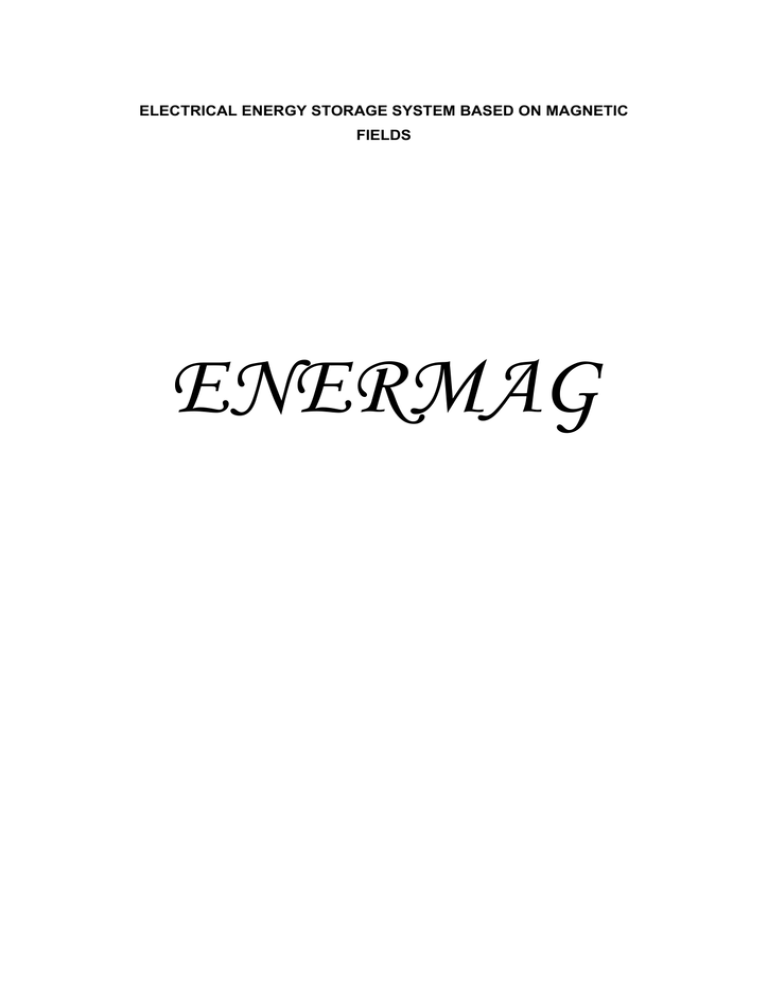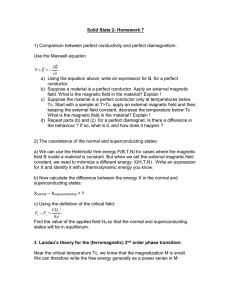electrical energy storage system based on magnetic fields
advertisement

ELECTRICAL ENERGY STORAGE SYSTEM BASED ON MAGNETIC FIELDS ENERMAG 1. OBJECTIVES AND STATE-OF-THE-ART 1.1 Project Objectives and Expected Achievements Basically there are two forms of storing electromagnetic energy without any intermediate conversion step: using electric or using magnetic fields. A device that store energy in one form is a capacitor while in another form is a magnet. The second form has not been seriously considered because it requires a permanent circulation of current and consequently has significant power losses. But with the advent of the superconductors; materials that present zero electrical resistance at very low temperatures, the later consideration have changed [1]. Even though the superconductivity phenomenon was discovered in Europe, as well as the “high temperature” superconducting ceramics, the second major revolution in this research area, United States and Japan lead the way in most commercial applications[2]. This fact is a even more surprising if we consider the strong research effort, in terms of man-power and money, made in last few years. Besides private investments and national initiatives, more than 38 major research European projects on superconductivity have been awarded by the EC. The present proposal will address that issue according to these two strategies: - fundamental research driven by the application. It is a complementary approach to both common strategies: doing laboratory basic research and applications will later emerge or application oriented research based on already available laboratory results. In this project the specifications formulated from application requirements are used to formulate the basic laboratory objectives. - the magnetic field strategy: a change in priorities. Currently the major objectives in superconducting research are increasing critical temperature and increasing critical current density where the critical magnetic flux density is considered a limiting factor rather than an objective; The project is structured around a new class of uninterruptable power supply with enough stored energy to replace both: the stack of batteries and the emergency diesel generator needed in large buildings and hospitals with critical loads. It will have the following major objectives: 1. Materials. Process development of Type II superconducting materials for working in the range of 20 - 64 Teslas of magnetic flux densities ; 2. Magnet. Development of a superconducting magnet capable of having an energy density larger than 400 kW-h/ m3; 3. Power electronic. Development of charge/discharge management system for a total current of 4,5 kA, as well as, the associated power electronic modules; 4. Control system Development of a digital control system for overall power regulation and protection in 380V/50Hz 3-phase circuits; 5. Small scale prototype. Manufacturing of small scale laboratory prototype of 356 kJ and upgraded in the second phase to 720 kJ (200 W-h) of stored energy ; 6. Full size design. Design and computer simulations of an uninterruptable power supply with instantaneous power ranting up to 2 MVA integrated in electrical energy installation of large buildings; 7. Assessment impact. Techno-economic assessments of this new class of power supply, based on superconducting magnet capable of storing up to 450 kW-h of energy, for large buildings and in association with wind-turbine energy sources in rural areas. These objectives have been defined according to a top down approach and the application requirements (7,6) determine even the basic research specifications (1) through a set of carefully structured levels (5,4,3,2). In the exploitation phases, besides the market introduction of a series of power supply units for critical loads in large and medium size buildings, it is envisioned to develop energy storage systems to operate in association to discontinuous sources of energy, such as wind-turbines. 1.2 State-of-the-art and degree of innovation One of the few applications in which superconductor technology is already having market success is in what is called SMES, specially small size or micro-SMES. Superconducting magnetic-energy storage units are designed to prevent short-term power glitches in places with critical loads [3]. In terms of stored energy, although significantly larger than units based on capacitor banks, they are small compared with electrochemical batteries. However, these units can release megawatts of power in less than two milliseconds to replace a sudden loss in line power or feeding and extra peak of energy required for connecting a load [4]. Current SMES units are based on classical superconductors, usually niobium titanium metallic alloys. These materials have the disadvantage of needing to be cooled at very low temperatures (around 1.8-4.2 K) [5]. This means a rather complex cooling system with liquid Helium as refrigerant and about 30 kVA of power consumption for medium size micro-SMES. So, a medium size 750 kVA-second unit become depleted without external energy release in less than a minute, a tiny fraction of the decay time that are common in electrochemical batteries. The power requirement for cryogenic cooling can be reduced an order of magnitude if liquid Nitrogen could be used as refrigerant. The boiling temperature of the Nitrogen is 77 K, low enough for the operation of the new type of superconducting ceramics. Besides, certain new superconductors provide another more important advantage; specially for magnetic field applications. While superconducting states at magnetic flux densities higher than 25 Teslas have not been obtained with the current superconducting alloys, it has been suggested that some superconducting ceramics could support magnetic flux densities much higher working at low enough temperatures[6]. As the energy density increases with the square of the magnetic field (B2/2μ), this means the possibility of having a quantum leap in the stored energy in magnets. The total 180 kW-h/m3 energy density of the best commercial electrochemical battery for power applications can be clearly surpassed with magnets working at 64 Teslas (in the coil core is reached almost 500 kW-h/m3 of power density). To fairly compare both technologies, the global energy density of the magnet has been calculated with the inclusion of the required cryogenic system with all its accessories. However, these new superconductor materials had structural and mechanical properties that greatly complicate their manufacture and use: mechanical brittleness; current transport depending on grains orientation; and energy dissipation due to the penetration of magnetic flux lines. As important as the chemical composition are dimensions, boundaries, microstructural defects and orientation of the grains in these polycrystalline superconductors. These characteristics are mainly related to manufacturing processes. In fact, probably today the main research effort is not so much in finding new materials that in findings new methods of manufacturing. So, organometallic deposition techniques, ion-bean-assisted deposition, melt-textured growth and many others manufacturing methods are under intense testing in a plethora of research centers around the world[7]. Within the new materials, probably, the major attention in the power sector is paid to BISCCO [2] . This superconducting material, which comes in two main variants: Bi2Sr2CaCu2O8 and Bi2Sr2Ca2Cu3O10 , has gained the world attention because it can be manufactured by a process called powder-in-tube that seems to address two major problems of superconducting ceramics: brittleness and density of current [8]. The technique involves packing the ceramic powder into a tube of silver or silver alloy, swaging and extruding the composite into wire and subjecting the wire to a thermomechanical treatment to align and texture grains. As the Dutch physicist Onnes, father of superconductivity, discovered, current density joins temperature and magnetic field in a triumvirate that govern whether or not a superconductor conducts with zero resistance. For example, the farther below its critical temperature a superconductor is cooled, the greater the current density and field it will withstand before reverting to normal resistivity. Likewise, the smaller the current flowing in the material, the greater the critical temperature and critical magnetic field become. Those critical values greatly depend on the material and its manufacturing process. Certain ceramic samples have critical magnetic fields so high that real laboratory instrumentation cannot measure them. Extrapolating from measurements of critical values at lower fields, researchers estimate they go as high as 200 Teslas at low temperatures and currents [6]. BISCCO represents a good model of the recent main effort at increasing the current density in the superconducting state with liquid Nitrogen as and industrial cheap cooling fluid, while the critical magnetic flux density is seen as an obstacle to overcome rather than an objective. In fact, BISCCO is not the best material for producing magnets due to its significant susceptibility to magnetic fields [8]. In this world-wide scenario with the magnetic field considered of secondary importance, Europe, in general, shows an even more conservative approach. For example, while it is difficult to find any major European research project aiming for continuous magnetic fields greater than 20 Teslas, the United State has recently built a full scale 45 Teslas hybrid magnet with 6,5 km of superconducting cables for the NHMFL in Tallahassee [9].



